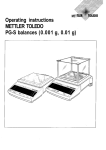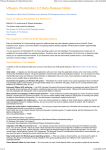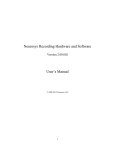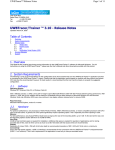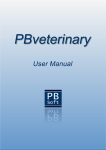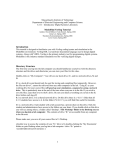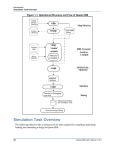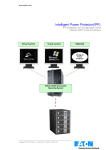Download VAssert Programming Guide
Transcript
Technical Note
VAssert Programming Guide
Workstation 6.5
This document introduces VAssert, an easy‐to‐use API that helps you investigate the behavior of applications running on virtual machines, after the applications run. Although VAssert was designed with debugging in mind, you can also use it to study performance and use patterns after the fact.
VAssert allows you to insert replay‐only code into your applications, incurring minimal performance overhead at runtime. After you record a virtual machine session, you can replay selected portions while performing data consistency checks and logging. You can ship VAssert code in released software, where it remains inactive and unobtrusive. In case of application failure, users can record a session so you can then activate VAssert code to provide root cause analysis of the problem.
CAUTION This release of the VAssert API is experimental. Interfaces might change in subsequent releases, and backward compatibility is not guaranteed.
About VAssert
In this release, the VAssert SDK is available for Windows guests only. Tested guest operating systems include Windows 2000, Windows XP, and Windows Vista, 32 bit or 64 bit. Windows 2003 Server and Windows 2008 Server are not verified. VAssert supports C++ and C programming.
VAssert uses the VMware® Workstation Record and Replay facility. In the Workstation 6.5 release, you can insert navigation markers while recording or replaying a session and quickly navigate to the markers during replay. You can also browse through a recording and choose the starting point for replay.
In addition, you can insert program statements that initialize the VAssert API, perform consistency checks, and log messages to a file, all at replay time only. The performance penalty of using VAssert is encountered almost entirely at replay time. Replay is deterministic (predictably the same) whether or not VAssert statements are present or enabled. The VAssert SDK is part of VMware Tools.
Example Use Case
The following scenario describes how VAssert could help diagnose the cause of application failure.
1
A customer reports that an application fails, but only after an extended period of heavy use. You cannot reproduce the failure on your development system.
2
You add VAssert checking and logging statements. You recompile the application and deliver it to the customer for test debugging.
3
The customer enables VAssert and begins recording on Monday morning, a time of heavy use. Because VAssert recording is extremely lightweight at runtime, users are unlikely to notice the recording activity. When the application fails, the customer restarts it to avoid service interruption, and turns off recording.
4
The customer sends you Monday’s recording. Because VAssert was enabled during recording, checking occurs during replay, and a session log is available. You are able to diagnose the problem. (The recording must come with packaged‐up virtual machine, and hardware configuration must be similar.) Copyright © 2008 VMware, Inc. All rights reserved.
1
VAssert Programming Guide
VAssert‐enabled applications can even run on native hardware (a physical machine without any virtual machines involved). This is not useful for replay debugging, but it is advantageous that the same binary works in both physical and virtual environments.
Traditional Assertions and Logging
Two time‐honored methods of debugging are to insert print statements, and to add assertions that verify programming assumptions. The VAssert API provides both methods.
The traditional assert() statement is a preprocessor macro defined by including assert.h in a C program. If its contained expression evaluates false, assert() writes the expression, source filename, and line number to standard error, then calls abort() to end the process and possibly produce a memory image. If disabled by NDEBUG, assert() has no effect.
The VAssert_Assert() statement is similar, but takes effect deterministically at replay time, unless you specify otherwise. Like traditional assert(), VAssert_Assert() is a macro.
Most system software sends activity and security‐related messages to a log file in a well‐known location, and application software often does the same. The VAssert_Log() statement sends messages to the vlog.txt file in the virtual machine’s directory at replay time, unless you specify otherwise. VAssert_Log() is also a macro.
NOTE VAssert statements must be enabled at record time. See “Enabling VAssert Recording” on page 3.
Best Practices
Although VAssert was designed for debugging, you can also use it for testing and performance analysis.
Offline Testing
You can use VAssert to improve the efficiency of automated offline testing. Normally, checking and logging I/O alters application behavior because of performance overhead. But with VAssert, software developers can include elaborate assertion checking and extensive logging in their code, and in‐house QA engineers can record testing sessions without suffering from slow performance. The recorded sessions can be replayed in the evening when there is less traffic, with expensive checking and logging activated. Application replay can also be completely automated. Later, developers can investigate and debug failures, if any.
Performance Analysis
To analyze performance of a database buffer pool, you can add VAssert code to collect a history of database accesses. This logging overhead normally skews the results if performed live online. With VAssert, you collect the log afterwards, without disturbing the access history. You can then analyze the data to design a better buffer pool replacement algorithm.
Setting up VAssert
This section describes how to install, locate, and enable VAssert.
Upgrading VMware Tools
When you install VMware Workstation, it creates a VMware Tools directory on the host, which contains an upgrader application to create a complete VMware Tools package on guest virtual machines.
To install the VAssert SDK
1
After installing a Windows guest operating system, on the guest select VM > Install VMware Tools.
2
Follow documented procedures to install or upgrade VMware Tools.
On Windows guests, the default VMware Tools folder is C:\Program Files\VMware\VMware Tools.
Copyright © 2008 VMware, Inc. All rights reserved.
2
VAssert Programming Guide
Locating the VAssert SDK
The VAssert package is now installed on the guest in the folder VMware\VMware Tools\VAssert SDK, which contains the following files:
bin\win*\libVAssert.lib – Link‐time library for VAssert programs.
lib\win*\libVAssert.dll – Dynamic link library for VAssert runtime.
examples\libVAssertTest.c – Sample application with command‐line options for VAssert statements.
include\vassert.h – Header include file for VAssert programs.
include\vassertShared.h – Internal file used by vassert.h; not important for programmers.
The VAssert SDK is tested with Microsoft Visual C++ 6.0, although later versions of Visual C++ are known to work. You need the SDK to modify your programs for debugging with VAssert. Add the header files to your project, and link with the libVassert.lib file.
Enabling VAssert Recording
VAssert functionality is disabled by default, because it incurs a small amount of overhead in the guest operating system, whether or not applications are using VAssert features.
To enable VAssert
1
Inside the Workstation host, shut down and power off the Windows guest.
2
In the Workstation user interface, select VM > Settings > Options > Snapshot/Replay.
3
Under Replay, select the Enable VAssert check box and click OK.
After enabling, any recorded application that includes VAssert can execute replay‐time code when replayed, regardless of the check box setting at the time of replay. Recordings created when the check box was deselected can never run replay‐time code, whether or not the application includes VAssert.
Enabling VAssert adds the following settings to the guest virtual machine *.vmx file. The first setting turns on VAssert features, and the second setting permits internal communication.
vassert.enabled = "TRUE"
isolation.tools.vassert.disable = "FALSE"
One related setting is not check box enabled in this release. It permits the use of VAssert statements to start and stop recording. See “Using VAssert_StartRecording()” on page 4 and “Using VAssert_StopRecording()” on page 5. You might want to add it to the *.vmx file.
isolation.tools.stateLoggerControl.disable = "FALSE"
Programming VAssert
This section describes how to call statements in the VAssert API.
Initialization
To initialize VAssert, VMware Tools must be installed on the Windows guest. Add the vassert.h header file to your C or C++ program, so VAssert_Init() can load the DLL and initialize the library:
#include "vassert.h"
...
if (!VAssert_Init()) {
cout << "Warning: cannot initialize VAssert library." << endl;
goto continue_without_vassert;
}
This function fails if isolation.tools.vassert.disable is set to TRUE. If you want to leave VAsserts statements in production programs and enable VAssert without recompiling, your application can ignore the return value of VAssert_Init().
Copyright © 2008 VMware, Inc. All rights reserved.
3
VAssert Programming Guide
Using VAssert_StartRecording()
You can use the Record and Stop facility in the Workstation user interface to record all or part of a VAssert‐enabled application running on a guest virtual machine. However, you can get finer‐grained control by placing a VAssert_StartRecording() statement exactly where you want it in your program. if (!VAssert_StartRecording()) {
cout << "Warning: cannot start VAssert recording." << endl;
}
A virtual machine must be powered on to start recording. You cannot begin recording when a recording is already underway, nor can you begin recording during replay.
You probably want to match VAssert_StartRecording() with a VAssert_StopRecording() statement.
Using VAssert_Assert()
The VAssert_Assert() statement is similar to other assert() statements, but takes effect deterministically at replay time, unless you specify otherwise. If VAssert was enabled during recording, at replay time the VAssert_Assert() macro evaluates its expression and terminates the application if the expression is false.
For example, before calling functions that expect a pointer to data and might crash given a null pointer, you can assert that the pointer is non‐null:
VAssert_Assert(ptr != 0);
You can also check for memory problems inside a long‐running program as described in “Example Use Case” on page 1 by asserting that memory allocation is within range after malloc():
VAssert_Assert(((char*)p) >= min_address);
VAssert_Assert(((char*)p) <= max_address);
In some cases, you might want to replace the underlying abort() routine so that the program does not fail, but instead provides helpful diagnostic information. See the define option VASSERT_CUSTOM_ABORT in “Compiler Flags” on page 7.
Going Live During Replay
The Record and Replay facility allows you to interrupt an in‐progress replay at any time and begin interacting with it. You can control this with the Go Live button in the user interface or programmatically with VAssert. At the point in your code where you want the application to go live, insert the following statement:
VAssert_Assert(FALSE);
The vassert.h include file defines VAssert_GoLiveMain(), which VAssert_Assert() calls internally.
Returning to Replay
You can return to replay by inserting the VAssert_ReturnToReplayMain() statement inside a VAssert code block. Make sure that the application is in replay state; otherwise this statement might cause the application to crash. Your program does not have to clean up program state, because VAssert restores it before returning to replay, thereby eliminating side effects from the VAssert_Assert() code block.
if (vassert_state.inReplay)
VAssert_ReturnToReplayMain();
One possible use for this statement is to exit early from a VAssert block. For example, in the code sequence below, VAssert_ReturnToReplayMain() exits both firstFunction() and secondFunction() without returning back through the calling code path.
VAssert_Assert(firstFunction()); // calls
→ firstFunction(); // which calls
→ secondFunction(); // which calls
→ VAssert_ReturnToReplayMain(); // end current VAssert and resume replaying
This is for advanced programmers.
Copyright © 2008 VMware, Inc. All rights reserved.
4
VAssert Programming Guide
Using VAssert_Log()
If VAssert was enabled during recording, at replay time VAssert_Log() sends printf() style output to the vlog.txt file on the VMware host for its respective virtual machine. For instance, a Windows XP guest on a Windows host sends output to C:\My Documents\My Virtual Machines\WindowsXP\vlog.txt or some similar path name. On Windows, VAssert_Log() calls _vsnprintf() internally, which is slightly different from the POSIX standard printf(). See the MSDN for reference information:
http://msdn2.microsoft.com/en‐us/library/56e442dc(VS.71).aspx
Because VAssert_Log() is implemented as a preprocessor macro, you must place the printf() format string inside double parentheses:
VAssert_Log(("Customer transaction number %u at %s\n", transactNum, ctime(&time) ));
This logging statement is useful for instrumenting your application without causing it to exit. For example, the long‐running program in “Example Use Case” on page 1 could write a log message before every operation with high overhead, giving you an idea of where it failed.
The VAssert_Log() statement might fail when printing floating point numbers expressed in %f or %g format. Using VAssert_StopRecording()
If you are interested in only a certain section of your application, you can stop a recording in progress with the VAssert_StopRecording() statement. Otherwise, recording continues to the end of program execution.
if (!VAssert_StartRecording()) {
cout << "Warning: cannot stop VAssert recording." << endl;
}
VAssert Reference
This reference includes sections about API statements, configuration options, compiler flags, and limitations.
API Statements
This release has five documented APIs:
Initialize
The initialization function returns TRUE if it is able to initialize the VAssert library; otherwise it returns FALSE.
#include "vassert.h"
extern char VAssert_Init(void);
Record
This statement begins the underlying system recording facility, sending to a snapshot object.
#define VAssert_StartRecording() VAssert_SetRecordingMain(1)
This function is effective only when the Enable VAssert check box is selected in the Workstation user interface.
Assert
If <expression> evaluates FALSE, this statement calls the system abort() routine to terminate the process, which you can attach with a debugger to determine the filename and line number of the failing assertion.
#define VAssert_Assert(<expression>) ...
It is possible to replace both the assert() routine and the abort() routine it calls; see “Compiler Flags” on page 7. You could for instance replace the abort() routine with one that calls another routine to emit __FILE__ and __LINE__ variables from the preprocessor.
Copyright © 2008 VMware, Inc. All rights reserved.
5
VAssert Programming Guide
Log
The log statement sends formatted output to the vlog.txt file of its respective virtual machine on the host.
#define VAssert_Log((<printf-string>)) ...
The VAssert_Log() statement might fail when printing floating point numbers expressed in %f or %g format. Stop
This statement ends the underlying system recording facility, closing the snapshot object.
#define VAssert_StopRecording() VAssert_SetRecordingMain(0)
This function is effective only when the Enable VAssert check box is selected in the Workstation user interface.
Configuration Options
Table 1 shows configuration options supported in the *.vmx file to control the behavior of VAssert. Options to control the logging behavior of VAssert_Log() are especially useful for customizing replay.
Table 1. VAssert Configuration Options
Option Name
Settings
Default
Description
vassert.enabled
TRUE
FALSE
FALSE
Determines whether VAssert functionality is enabled for new recordings. The default FALSE means that VAssert is not enabled.
isolation.tools.vassert.disable
TRUE
FALSE
TRUE
Determines whether VAssert functionality is exposed to guests. Use this only in conjunction with vassert.enabled. The default TRUE means VAssert functionality is not exposed to guests.
vassert.logFile
<filename>
vlog.txt
Destination filename for VAssert_Log() output, created in the guest virtual machine’s directory on the host.
vassert.logMode "prompt"
"prompt"
Indicates what to do when a VAssert_Log() produces output, and the log file already exists.
"append"
"replace"
“append” means append to the log file.
"discard"
“replace” means replace the log file.
“discard” means preserve the old log file and discard any new log output.
“prompt” means to prompt with a dialog box, so the user can select one of the above options.
vassert.maxLogFileSize
<number>
–1
Limits the log output file to a maximum file size in bytes. The default –1 means no maximum limit, so the log file can grow as much as needed.
vassert.maxTime
<number>
10
Limits the amount of time spent executing VAssert_Assert() to the given number of seconds. Any invocation lasting longer than that is terminated. Specifying zero means that no limit is enforced.
The imposed limit is not exact. It is never less than the specified duration, although it could be more.
Copyright © 2008 VMware, Inc. All rights reserved.
6
VAssert Programming Guide
Compiler Flags
In the SDK, compiling with the VASSERT_ALWAYS_EXECUTE flag causes the VAssert_Assert() and VAssert_Log() calls to be treated as normal assert and log statements at runtime. In other words, they execute all the time, like standard assert(), not only at replay time.
You can define the following macros before including the vassert.h header file in a program. These macros specify replacement abort, assert, and log statements:
VASSERT_CUSTOM_ABORT — When an assertion fails, VAssert ends replay and makes the virtual machine go live, so it begins accepting new input from the user. If this occurs, VAssert_Assert() inserts the VASSERT_CUSTOM_ABORT macro to halt the application and report an error. The VASSERT_CUSTOM_ABORT macro by default calls the standard library abort(), which prints a generic error message and allows you to attach a debugger to get details about the failure. You can alter this macro to provide more information, such as the __FILE__ and __LINE__ number of the failed assertion. Because VASSERT_CUSTOM_ABORT is inserted after the end of replay, the I/O restrictions in “Limitations” on page 7 do not apply. This macro can print output.
VASSERT_CUSTOM_ASSERT – If the VASSERT_ALWAYS_EXECUTE flag is defined at compile time, VAssert_Assert() becomes a wrapper around VASSERT_CUSTOM_ASSERT, whose default definition is to call the standard library assert().
VASSERT_CUSTOM_LOG – If the VASSERT_ALWAYS_EXECUTE flag is defined at compile time, VAssert_Log() becomes a wrapper around VASSERT_CUSTOM_LOG, whose default definition is to call the standard library printf().
Limitations
Replay‐time code running with VAssert has the following limitations:
Vassert code cannot perform I/O or cause I/O to be performed. It cannot execute in and out assembly instructions, nor can it read or write memory‐mapped regions. Swapping might cause implicit I/O, so do not run VAssert code near physical memory limits. When the VAssert library detects I/O, it terminates and skips the offending replay‐time code. Subsequent VAssert execution remains undisturbed.
You cannot display output using VAssert_Assert(), because calling printf() or opening a dialog box inherently produces I/O. The only way to produce user‐visible output is by using VAssert_Log() or by defining VASSERT_CUSTOM_ABORT, which is allowed to produce I/O because it executes after an assertion has failed and replay has stopped.
Replay‐time code cannot depend on the delivery of interrupts. For example, timer interrupts and I/O interrupts are not delivered during replay‐time execution.
If a guest application terminates abruptly, the VAssert DLL might de‐initialize improperly. This could happen when you forcibly terminate processes with Windows Task Manager. If improper de‐initialization occurs, spurious VAssert invocations might cause replay glitches. At worst, spurious invocations can cause replay to halt indefinitely, although you can manually stop replaying if you notice that progress has terminated. Normally, spurious VAssert invocations have no noticeable effect during replay, and valid VAssert invocations run undisturbed. When the VAssert DLL re‐initializes because of a VAssert_Init() call in the recording, it prevents spurious invocations during further replay.
Replay‐time code must not modify the privileged guest CPU state. This includes CR0, CR4, and Machine Specific Registers. However, modifications to normal non‐privileged CPU state, such as the CPU general purpose registers and flags, the segment registers, and address space modifications (that is, assignments to CR3) are permitted.
When replaying a recording that has VAssert enabled, the Suspend and Add Marker operations are disabled in the Workstation user interface.
Copyright © 2008 VMware, Inc. All rights reserved.
7
VAssert Programming Guide
Performance Implications
The VAssert APIs defer execution of some code from recording to replay. This generally makes the record‐time execution of a program faster when VAssert calls are not evaluated, and the replay‐time execution slower when VAssert calls are evaluated. To implement this facility, the VAssert library must add overhead to the replay‐time execution. Testing indicates overheads of hundreds of microseconds per VAssert. Depending on the rate of VAssert invocations per second, this can make replay‐time execution much slower than record‐time execution. For example, if during recording, your program runs 15 million VAssert invocations in one second, replay‐time execution could take substantially longer (15 million x 500 microseconds = over 2 hours).
Plan for these performance slow‐downs either by using more complex but more sparsely packed VAsserts, or by scheduling an appropriate amount of time to perform replay, such as overnight or batched.
Support and Feedback
See the “Record and Replay” chapter in the Workstation 6.5 User’s Manual for information about the underlying facility and its user interface.
If you encounter any issues while programming VAssert, post your questions in the VMware Workstation 6.5 communities forum or in VMware communities that discuss developer products. If you have any technical inquiries or suggestions, send email to vassert‐[email protected].
If you have comments about this documentation, submit your feedback to: [email protected]
VMware, Inc. 3401 Hillview Ave., Palo Alto, CA 94304 www.vmware.com
Copyright © 2008 VMware, Inc. All rights reserved. Protected by one or more of U.S. Patent Nos. 6,397,242, 6,496,847, 6,704,925, 6,711,672, 6,725,289, 6,735,601, 6,785,886,
6,789,156, 6,795,966, 6,880,022, 6,944,699, 6,961,806, 6,961,941, 7,069,413, 7,082,598, 7,089,377, 7,111,086, 7,111,145, 7,117,481, 7,149, 843, 7,155,558, 7,222,221, 7,260,815,
7,260,820, 7,269,683, 7,275,136, 7,277,998, 7,277,999, 7,278,030, 7,281,102, 7,290,253, 7,356,679, 7,409,487, 7,412,492, 7,412,702, and 7,424,710; patents pending. VMware, the
VMware “boxes” logo and design, Virtual SMP, and VMotion are registered trademarks or trademarks of VMware, Inc. in the United States and/or other jurisdictions. All other
marks and names mentioned herein may be trademarks of their respective companies.
Item EN-000079-00
8








